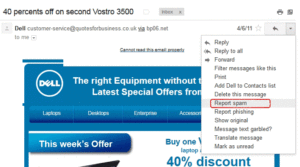The connection between spam emails and SEO
These two areas can seem unrelated at first glance but there’s more connections between the two than you may think. If you have followed all SEO best practice rules and still cannot find your website in Google’s natural listings there may be more to it than just a simple case of poor optimisation.
And one of the areas you should review is email marketing.
Google’s algorithm will take a diverse number of factors into account to calculate your PageRank. One of them being your online reputation. And being regularly listed as a spammer on various websites won’t help your natural rankings.
Being reported as a spammer only takes one click
Reporting someone as an email spammer is pretty easy nowadays within ISP email programs like Gmail for 
example. All the user needs to do is click on a button to categorise your communication as spam. And as you know, Gmail is owned by Google, so it’s not too difficult to guess they will make something out of this information. All other major ISP’s such as Hotmail or Yahoo also have their own reporting tool and just like Gmail, you’re only one click away from being classified as a spammer.
In addition any recipient has the possibility to report you as a spammer through organisations such as Spamcop, Spam Assassin or Spamhaus, amongst many others.
Public spammer listings
Every time someone reports you as a spammer you end up on the public blacklists of these organisations. It also just takes someone mentioning your company name and the word spam in the same sentence on their blog or on a forum to suddenly bring down your online reputation.
What Google bots will make of this information is unclear but they will check all links and mentions of your name online when ranking your website. So being mentioned as a spammer is definitely a bad thing and it will take you quite some effort to dissociate your company name from this term.
Tips to avoid being reported as a spammer
-
Avoid using third party email lists
Providers of those will always claim that their lists are opt-in, but opt-in to what exactly? Surely not to your email communications. When recipients see your email in their inbox they will immediately find it suspicious and may be tempted to report you as a spammer.
-
Don’t send emails too frequently
Recipients may find it annoying if they receive emails from your company too often, especially if they are always more or less about the same topic. Once again they may be tempted to report you as a spammer rather than just unsubscribe. So do not take any risk and reduce your email frequency if you have already received feedback that your users were fed up with receiving too many emails from your company.
-
Change your email designs and content regularly
People will always expect something new and original from you. Don’t disappoint them. Refrain from sending anything if you do not have any new design ready. Make sure your subject lines are different from one send to another. If you follow these basic steps the chances to upset your recipients will be slim and you should avoid being reported as a spammer.
-
Check your unsubscribe link
First of all make sure that there’s always one and that it’s working properly. Nothing’s more annoying to a user than to be unable to opt out of your email marketing lists if they wish to. Also remember that some of them may not want to use the link so check your emails regularly for unsubscribe requests and make sure you remove them from the list before every send.
-
Don’t use too many spam words
These can lead to new users labelling you as spammers very quickly. Segment your database and make sure you avoid words like free, offer or cash in the first email sent to your new users.
-
Clean your database regularly
Make sure you get rid of all spamtrap emails. Spamtraps are email addresses created to lure spammers. Every time you send something to one of those, chances are that your IP address and domain name will end up on public blacklists. Some are very obvious as the email address will contain the word spam in it. Scan your database and remove all of those.
Other spamtraps will be more difficult to detect but as long as you have followed all best practices and only sent marketing emails to your users there should not be any of those in your database. In addition remove all bouncers regularly from your database. Sending emails to the same bouncers repeatedly will damage your IP addresses and could once again lead to your domain name being listed as a spammer.
![]() Being reported as a spammer can badly damage your online reputation and consequently your natural rankings. While it will not be the only factor affecting your search engine results you should still regularly check your domain name is not blacklisted. And review your email marketing processes if that’s the case.
Being reported as a spammer can badly damage your online reputation and consequently your natural rankings. While it will not be the only factor affecting your search engine results you should still regularly check your domain name is not blacklisted. And review your email marketing processes if that’s the case.


